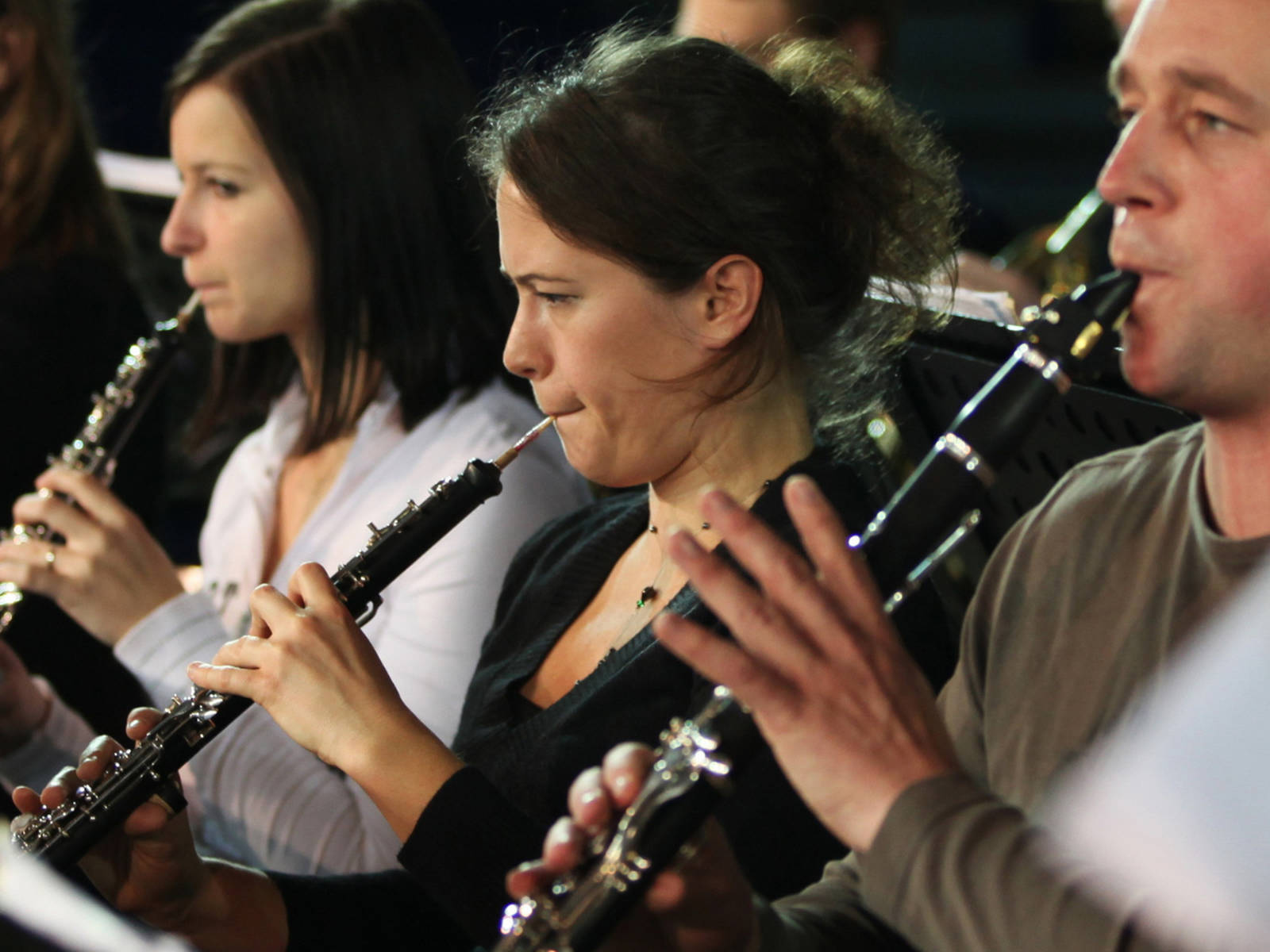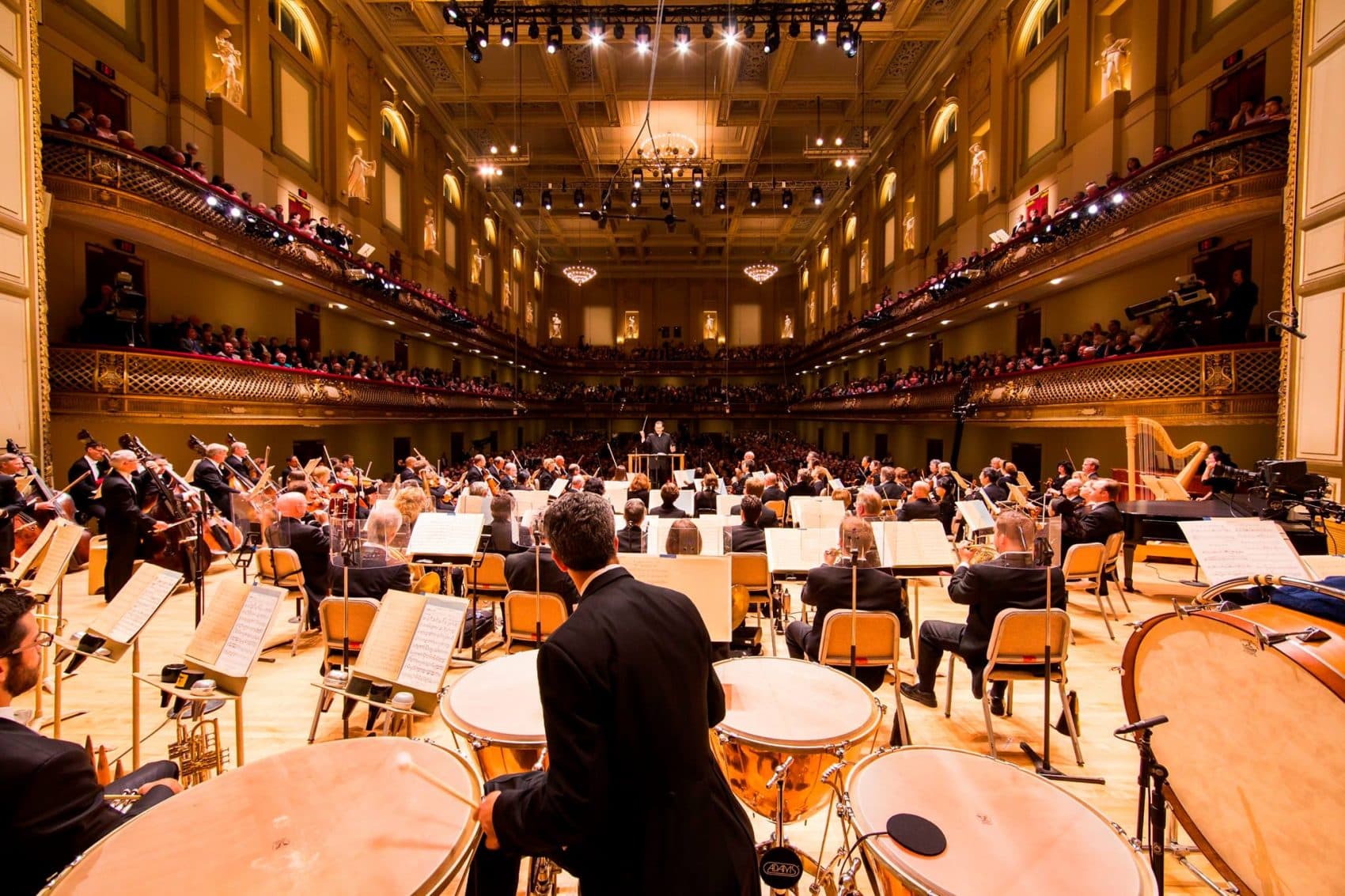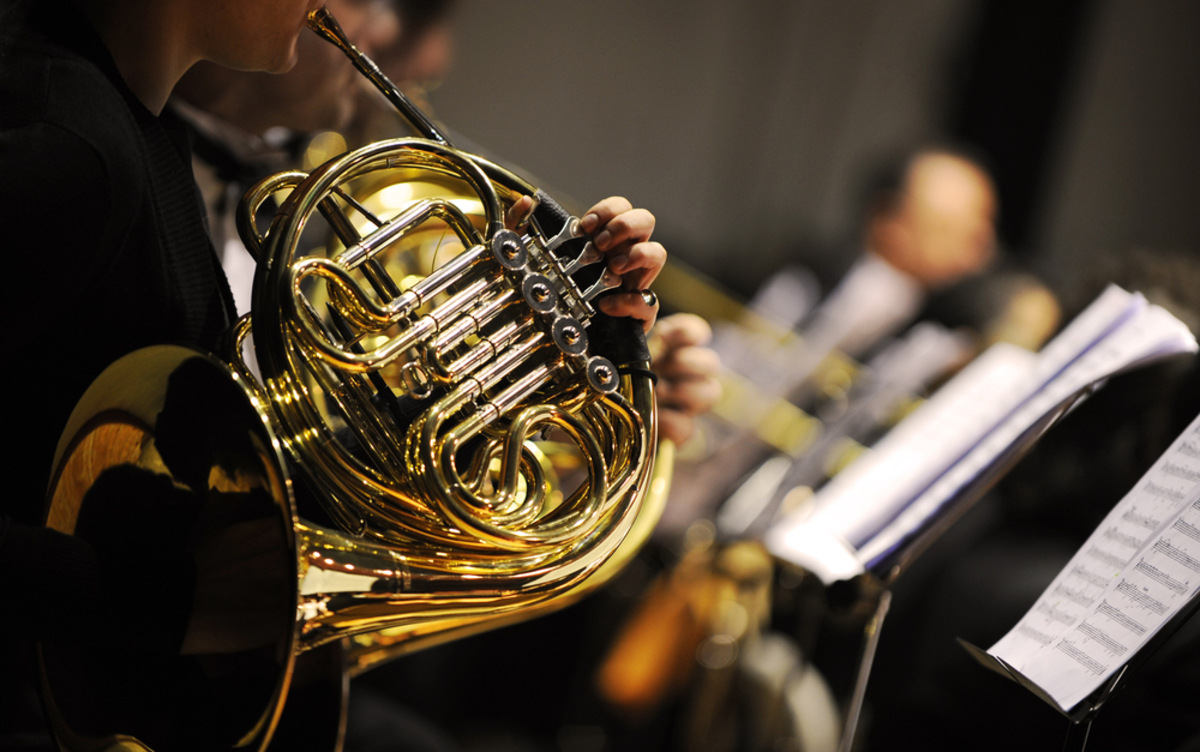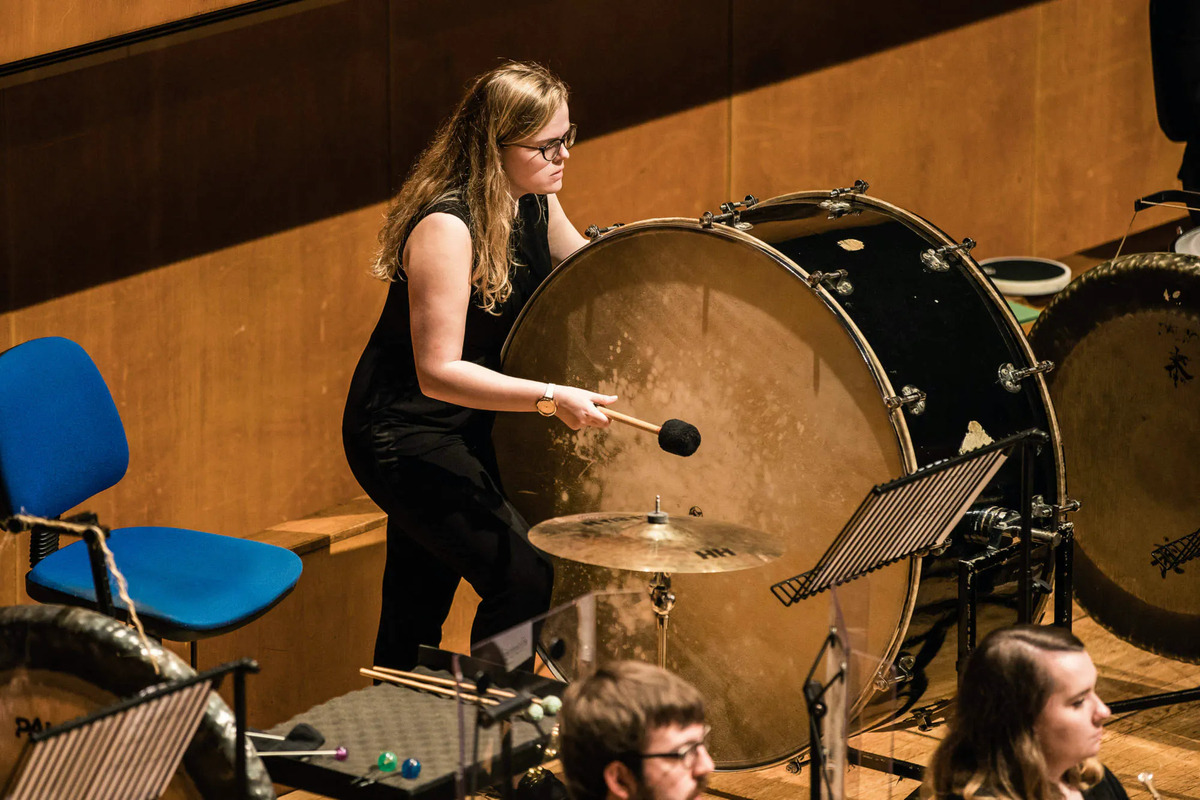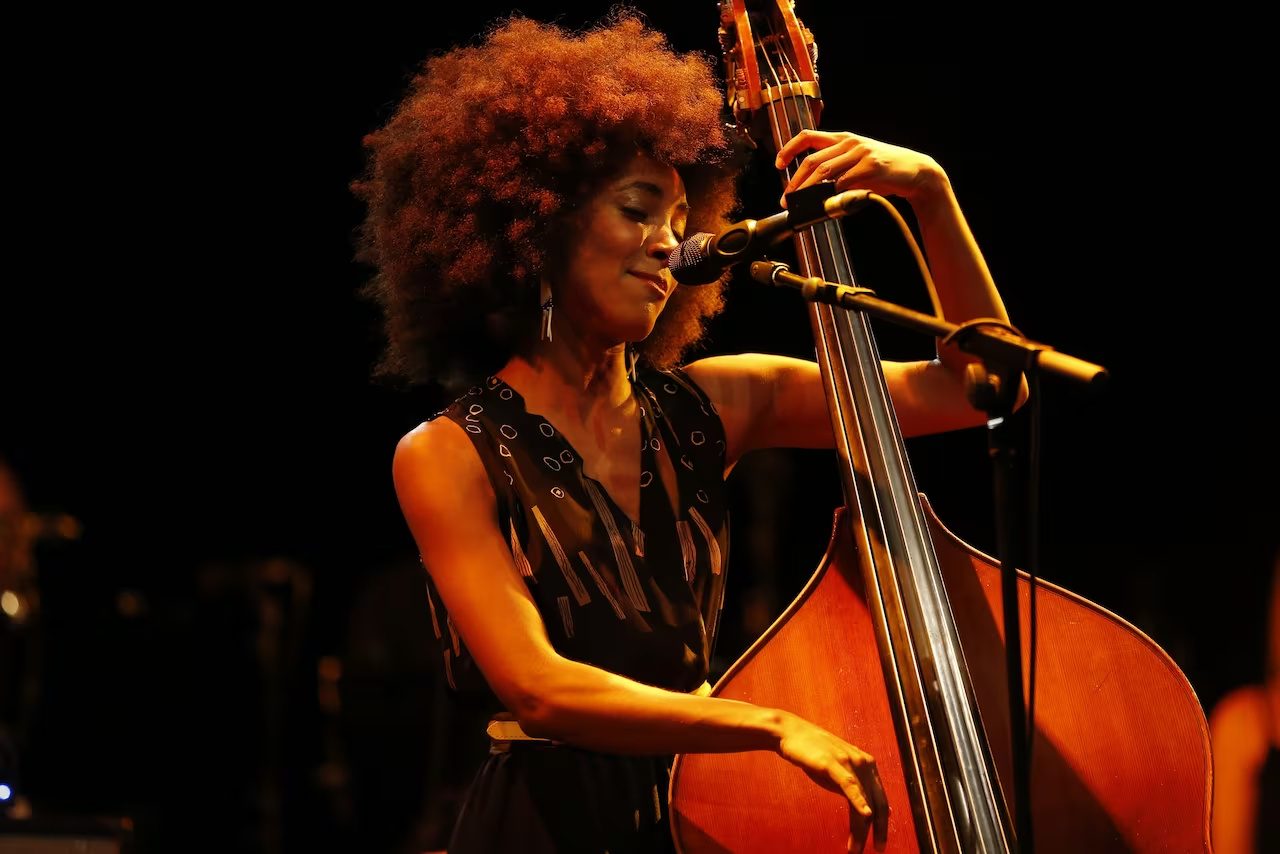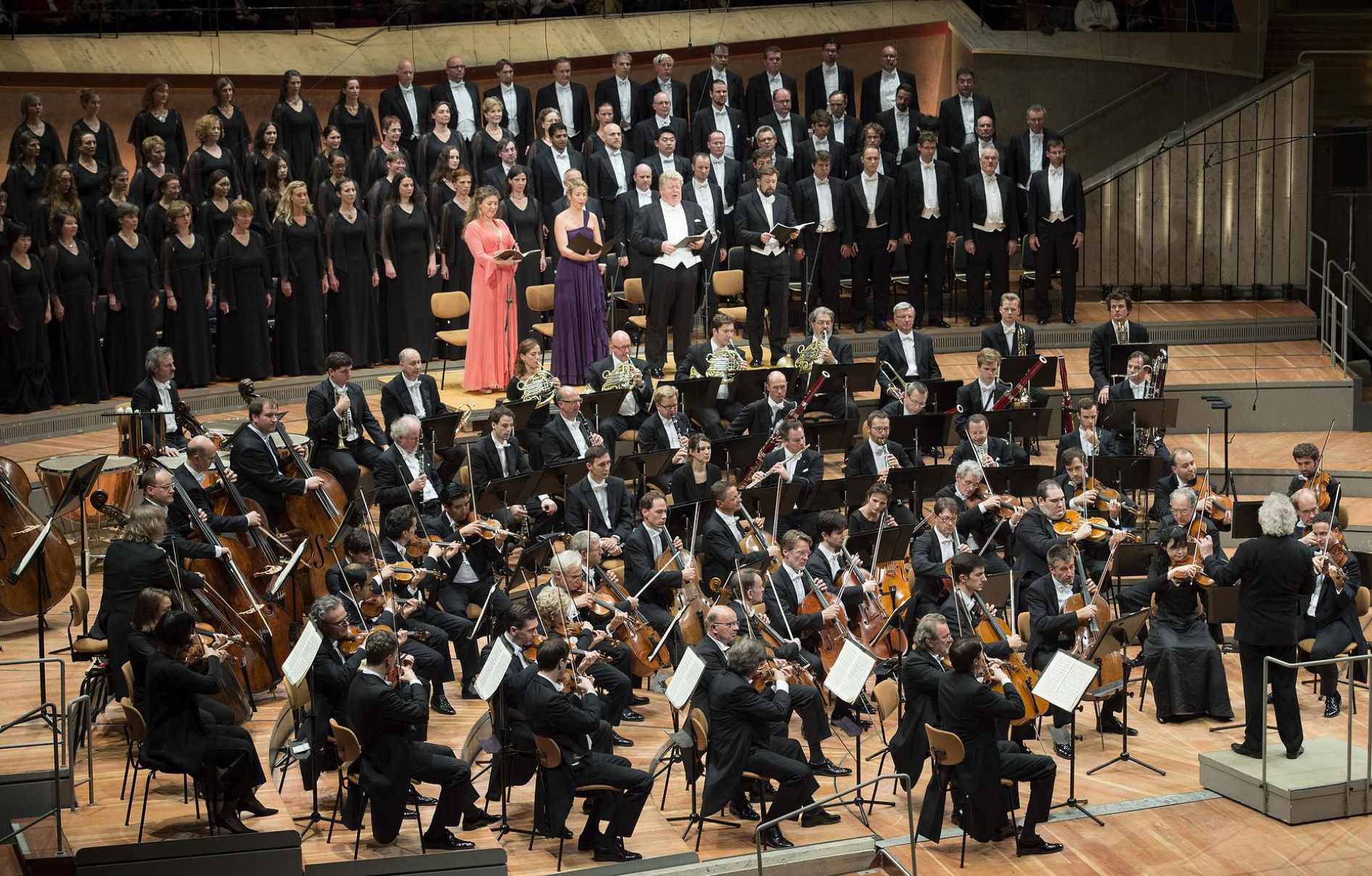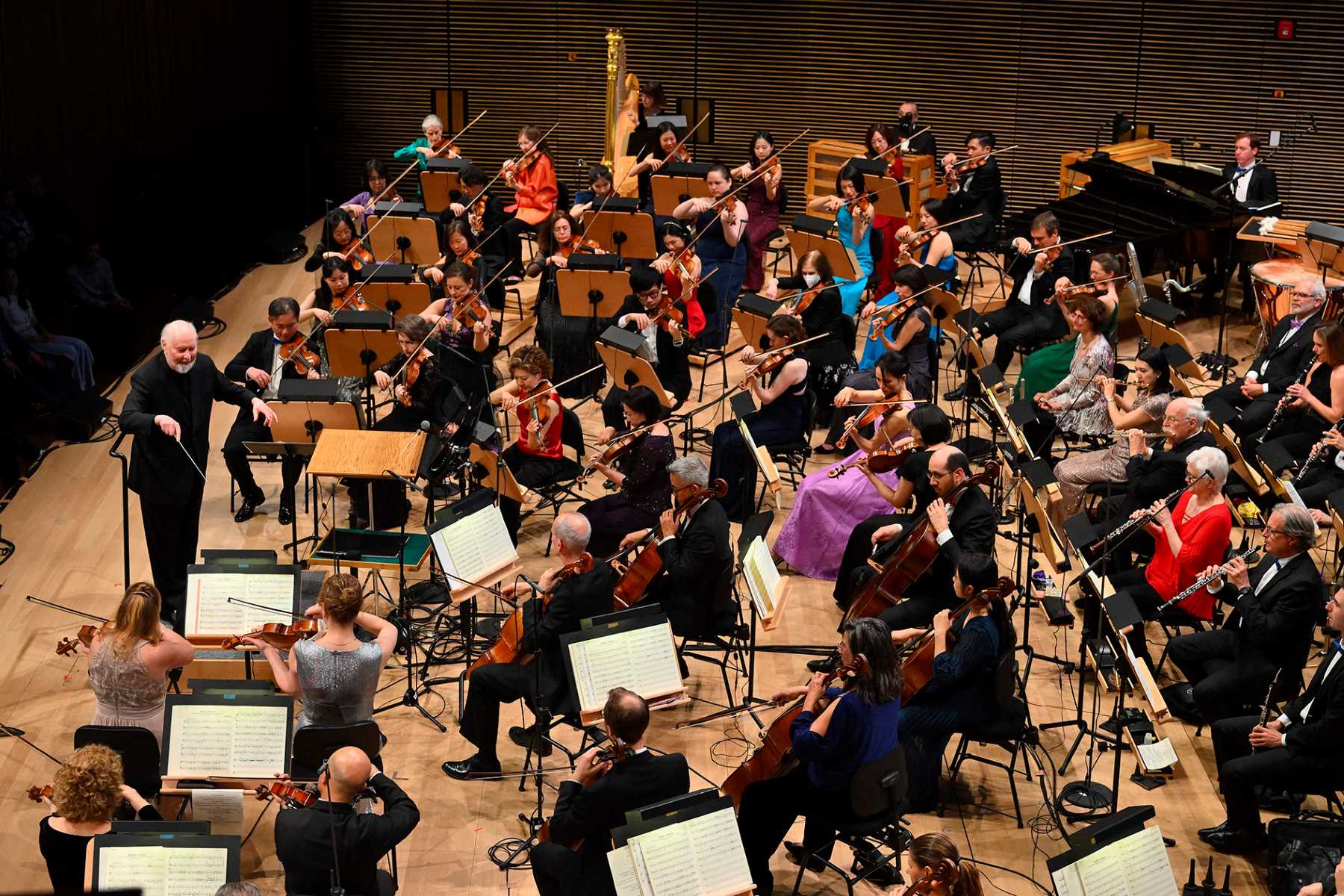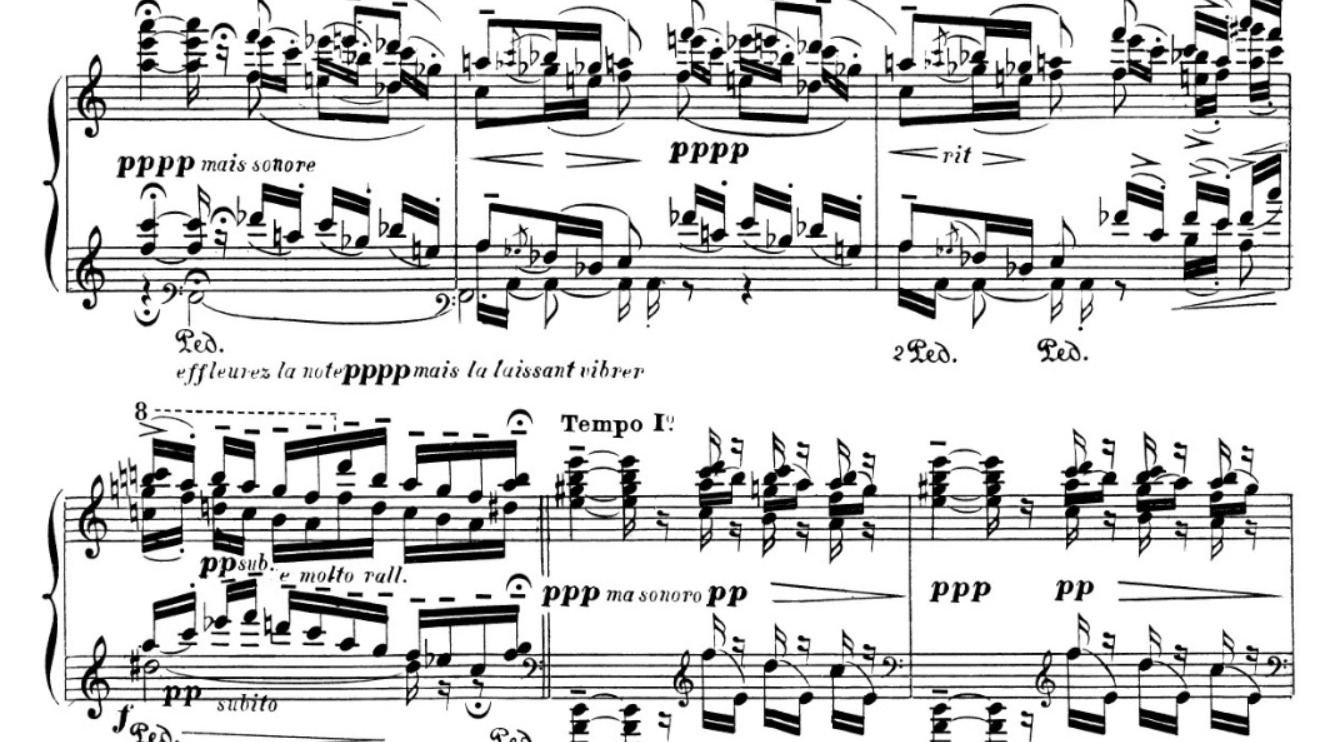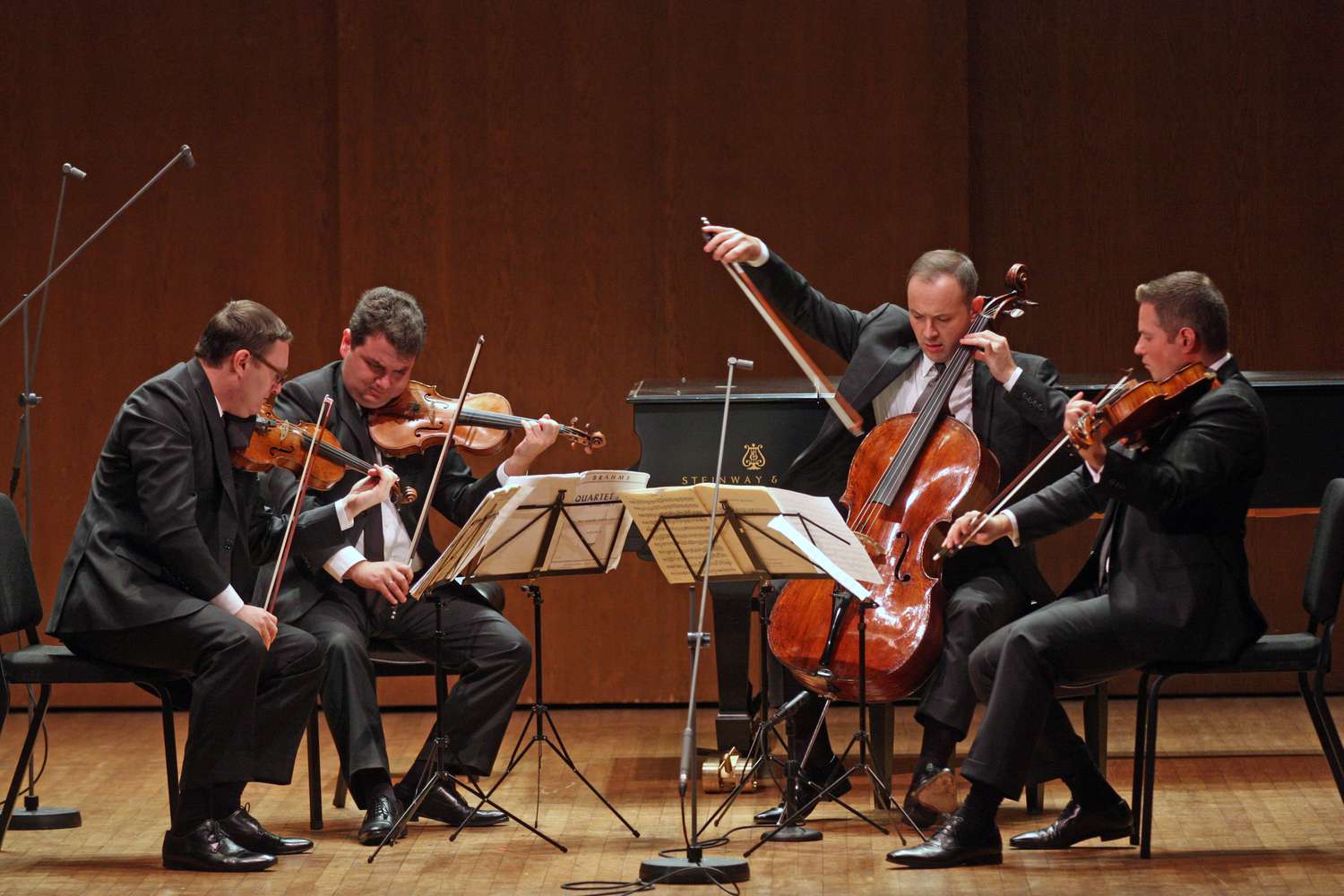Home>Genres>Symphony>What String Instruments Would You Usually Find In A Symphony Orchestra
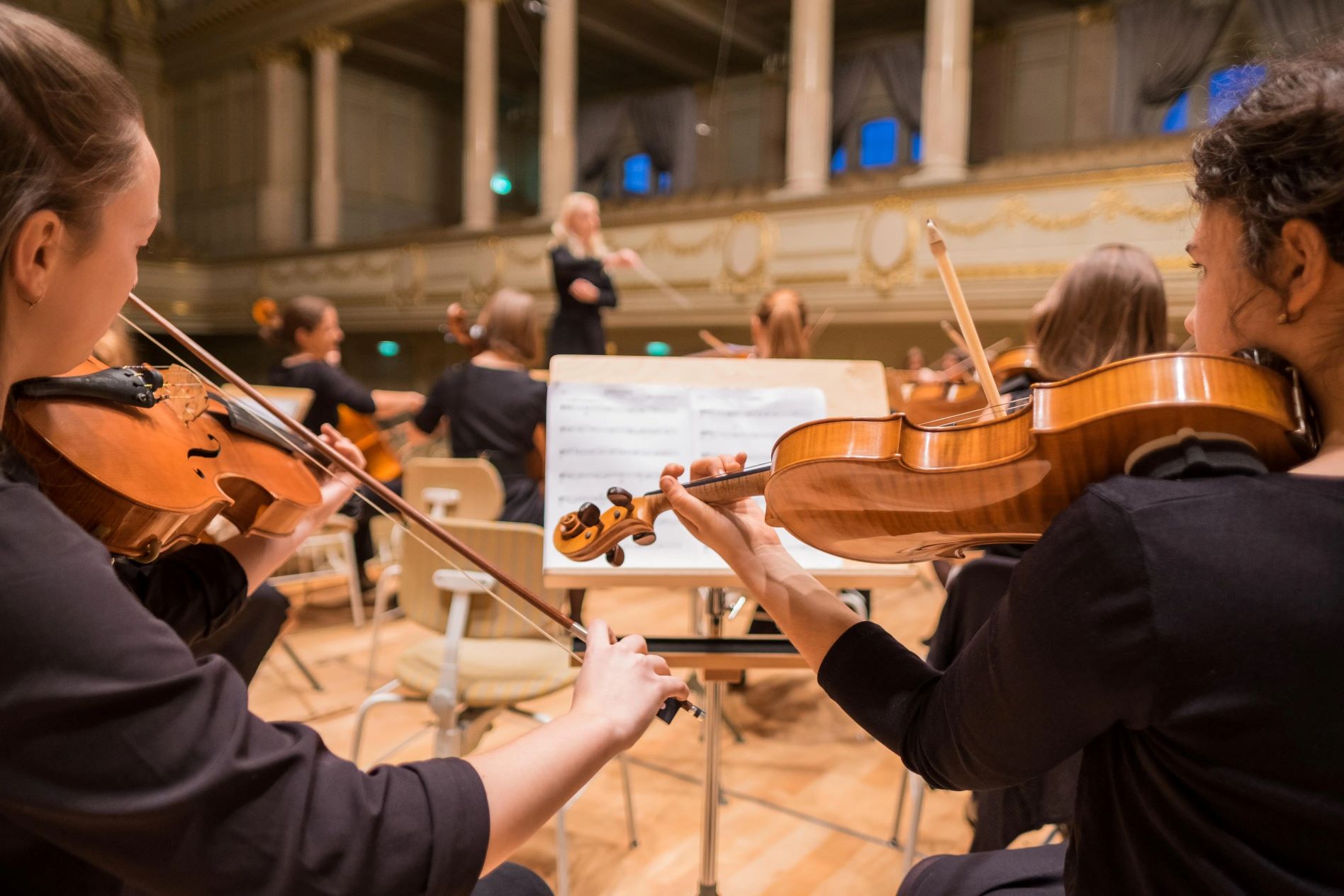

Symphony
What String Instruments Would You Usually Find In A Symphony Orchestra
Modified: January 22, 2024
Discover the captivating world of symphony orchestras and explore the enchanting sounds of various string instruments, including violin, viola, cello, and double bass.
(Many of the links in this article redirect to a specific reviewed product. Your purchase of these products through affiliate links helps to generate commission for AudioLover.com, at no extra cost. Learn more)
Table of Contents
Introduction
A symphony orchestra is a powerful ensemble consisting of various musical instruments that come together to create a grand and harmonious sound. It is a collective of talented musicians who work in unison under the direction of a conductor to bring the music to life.
The origins of the symphony orchestra can be traced back to the 17th century, with the development of the modern orchestra occurring in the 18th and 19th centuries. Today, the symphony orchestra remains a staple in classical music, performing intricate and masterful compositions from renowned composers such as Mozart, Beethoven, and Tchaikovsky.
Each instrument in the symphony orchestra has a distinct role, contributing its unique timbre and skill to the overall sound. From the soaring melodies of the violins to the powerful rumble of the timpani, each instrument plays a crucial part in creating the rich and dynamic symphony orchestra sound.
In this article, we will explore some of the string instruments and other key components that you would typically find in a symphony orchestra. Let’s dive into the world of orchestral music and discover the instruments that bring it to life.
Violin
The violin is one of the most prominent instruments in a symphony orchestra. It typically serves as the lead instrument and is known for its soaring and expressive melodies. The violin has a beautiful and versatile sound that can evoke a wide range of emotions.
With its four strings, the violin is played by drawing a bow across the strings or plucking them with the fingers. The instrument produces a rich and resonant sound that can vary in tone and intensity depending on the technique and style of the player.
The violin sits at the heart of the orchestra, occupying the first violin section. The first violinists often play the melody and intricate passages, while the rest of the section provides harmonies and support. The violin section plays a vital role in creating the lush and vibrant sound of the symphony orchestra.
Many famous composers have written beautiful and challenging violin concertos, showcasing the instrument’s virtuosity and expressive capabilities. Some well-known violin concertos include Beethoven’s Violin Concerto in D major and Tchaikovsky’s Violin Concerto in D major.
It is worth noting that the violin has a long history and is also played in various other musical genres, including folk, jazz, and contemporary music. Its versatility and timeless appeal have made it a beloved instrument among musicians and audiences alike.
Viola
The viola is often considered the “middle voice” of the string section in a symphony orchestra. It closely resembles the violin in shape and structure but is slightly larger in size, resulting in a warmer and deeper tone.
While the violin takes the spotlight with its soaring melodies, the viola provides a rich harmonic foundation and plays an essential supporting role in the orchestra. Its unique tonal qualities add depth and richness to the overall sound.
Similar to the violin, the viola is played with a bow or can be plucked with the fingers. However, due to its larger size and longer strings, the viola requires slightly different playing techniques and fingering positions.
The viola section usually sits behind the first violin section and consists of several players. Together, they create a lush and cohesive sound, adding depth and complexity to the overall orchestral texture.
While the viola often plays accompanying harmonies and countermelodies, it also has its moments to shine with solos and expressive passages. Composers such as Mozart and Brahms have written beautiful music that showcases the viola’s unique voice.
Although often overshadowed by the violin, the viola possesses a distinct charm and character that adds a layer of depth to the symphony orchestra. Its warm and mellow tones provide a beautiful contrast to the brightness of the violin and the lower strings.
Outside of the symphony orchestra, the viola is also featured in chamber music ensembles and string quartets, where its expressive qualities can be fully appreciated. The viola’s versatility and unique voice make it an indispensable part of the orchestral family.
Cello
The cello, also known as the violoncello, is a powerful and expressive instrument that belongs to the string family. It is larger than the viola and produces a deep, resonant sound that is often described as rich and soulful.
Like the violin and viola, the cello is played with a bow or can be plucked with the fingers. Its size allows for a wide range of expressive techniques, including passionate bowing and intricate fingerings.
The cello is known for its versatility and ability to evoke a wide range of emotions. It can produce both melodic and accompanying lines, making it a versatile instrument in the symphony orchestra.
In the orchestra, the cello section typically sits in the center, with the cellists sitting side by side and facing the conductor. They provide a solid foundation for the string section and often play the bass line, adding depth and richness to the overall sound.
The cello is capable of producing a wide dynamic range, from soft and delicate to powerful and intense. Its expressive capabilities have made it a favored choice for composers to write deep and emotional melodies.
Famous cello concertos, such as Dvořák’s Cello Concerto and Elgar’s Cello Concerto, showcase the instrument’s lyrical and virtuosic qualities. These compositions highlight the cello’s ability to captivate audiences with its soul-stirring performances.
Outside of the symphony orchestra, the cello is also a popular instrument in chamber music, where it often takes on the role of a soloist or collaborates with other instruments in small ensembles.
The cello’s rich and expressive sound, combined with its versatile playing techniques, has earned it a special place in both classical and contemporary music. Its deep and resonant tones add depth and beauty to any orchestral or chamber ensemble.
Double Bass
The double bass, also known as the contrabass, is the largest and lowest-pitched instrument in the string family. It provides the foundation of the orchestra’s sound, anchoring the harmonies and adding depth to the overall ensemble.
With its deep and resonant tones, the double bass is often responsible for playing the bassline and reinforcing the low end of the orchestral texture. Its size and length of the strings contribute to its rich and powerful sound.
The double bass is unique in its playing technique as it can be played with a bow or plucked with the fingers. The plucking technique, known as pizzicato, adds a percussive and rhythmic element to the instrument’s sound.
The double bass section typically sits at the back of the orchestra, with multiple bassists playing together to create a strong and resonant foundation. Their synchronized playing provides stability and support to the entire ensemble.
In addition to its role as the backbone of the orchestra, the double bass occasionally has solo moments, where it showcases its melodic capabilities and expressive depths. Composers like Bottesini and Dittersdorf have written virtuosic solo pieces to highlight the instrument’s versatility.
Outside of the symphony orchestra, the double bass is also a crucial component of jazz, rock, and popular music genres. Its deep and rich tones provide a solid and driving rhythm, making it an essential instrument in various musical styles.
Due to its size and range, the double bass requires skilled and dedicated musicians to handle its demanding physicality. The instrument’s presence adds gravitas and power to the orchestra and creates a strong sense of grounding in the ensemble’s sound.
The double bass is truly the giant of the string section, providing the low frequencies and solid foundation that complete the harmonic spectrum of the symphony orchestra.
Harp
The harp is a stunning and ethereal instrument that adds a touch of magic to the symphony orchestra. With its graceful curves and delicate strings, the harp produces a resonant and heavenly sound that enhances the overall orchestral texture.
The harp is unique in its design and technique. It consists of a series of strings, which are plucked by the player’s fingers or a set of pedals. The strings are tuned to different pitches, allowing the player to create a mesmerizing and melodic cascade of notes.
In the symphony orchestra, the harp is often positioned towards the back, slightly off-center. Despite its size, the harp’s sound carries effortlessly throughout the ensemble, adding a shimmering and mystical quality to the music.
While the harp can provide accompaniment and harmonies, it also has moments to shine with solo passages and beautiful melodic lines. Composers like Debussy and Ravel have utilized the expressive capabilities of the harp to evoke dream-like and enchanting atmospheres in their compositions.
With its elegant and intricate playing technique, the harp requires considerable skill and precision from the musician. The harpist’s hands glide across the strings, plucking each note with care and sensitivity.
Beyond its role in the symphony orchestra, the harp is also a prominent instrument in solo and chamber music settings. Its angelic sound has made it a beloved choice for solo performances and provides a magical presence in smaller ensemble settings.
Additionally, the harp is often associated with folklore and mythology, with its enchanting sound bringing to mind ancient tales and fantastical worlds. Its inclusion in a symphony orchestra adds a touch of whimsy and wonder to the overall musical experience.
Overall, the harp’s unique sound and aesthetic make it a captivating and essential component of the symphony orchestra. Its delicate melodies and ethereal qualities transport listeners to a realm of beauty and imagination.
Flute
The flute is a versatile and enchanting instrument that adds a bright and vibrant element to the symphony orchestra. With its ability to effortlessly navigate through melodic lines and produce a pure and piercing sound, the flute takes on a prominent role in the ensemble.
The flute is made of metal or wood, with a series of keys and finger holes that the musician uses to control the pitch and sound. Its small size allows for agile and expressive playing, making it capable of both delicate and virtuosic passages.
Within the symphony orchestra, the flute section typically consists of multiple players who work together to create a seamless and unified sound. The flutists play various roles, from carrying melodic lines to providing atmospheric textures and harmonies.
The flute’s bright and airy sound can cut through the orchestral texture, adding sparkle and brilliance to the overall sound. It often contributes to the upper registers and brings a sense of lightness and clarity to the music.
Composers have written countless beautiful and iconic flute solos and concertos, highlighting the instrument’s agility and lyrical qualities. Famous examples include Mozart’s Flute Concerto No. 1 in G major and Debussy’s “Syrinx” for Solo Flute.
Aside from its role in the symphony orchestra, the flute is also a popular instrument in other musical genres, such as jazz and folk music. Its versatility and melodic capabilities make it a beloved choice among musicians.
Playing the flute requires skill and control, as players must master the technique of producing a clear and focused sound. The flutist’s breath control and finger dexterity contribute to the instrument’s expressive potential.
Overall, the flute brings a delightful and melodic presence to the symphony orchestra. Its radiant and agile sound adds a touch of elegance and charm, making it an indispensable part of the ensemble.
Piccolo
The piccolo is a small but powerful instrument that belongs to the woodwind family. It is essentially a smaller version of the flute, producing a higher and more piercing sound. Despite its size, the piccolo is capable of creating a big impact in the symphony orchestra.
The piccolo is known for its bright and shrill sound, which adds a distinct and vibrant element to the orchestral texture. Its piercing tone allows it to cut through the ensemble, making it especially effective in creating accents and adding brilliance to the music.
Similar to the flute, the piccolo is made of metal or wood and is played by blowing air across a mouthpiece while pressing down on the keys and finger holes. The fingers must be particularly precise due to the piccolo’s smaller size, allowing for quick and agile playing.
In the symphony orchestra, the piccolo is often used to enhance certain passages or add dramatic effects. It is commonly found in marches, where its high-pitched sound complements the energetic and festive atmosphere.
While the piccolo may not have extensive solo passages in orchestral music, it can shine in chamber music and in solo performances. Composers such as Prokofiev and Nielsen have featured the piccolo in their compositions, allowing the instrument to display its unique characteristics.
Playing the piccolo requires precision and control, as its high register demands accurate fingerings and impeccable breath control. The musician must have a strong embouchure to produce the clear and powerful sound that the piccolo is known for.
The piccolo adds a touch of excitement and brilliance to the symphony orchestra. Its distinctive sound brings a unique and vibrant presence to the ensemble, elevating the overall musical experience.
Oboe
The oboe is a beautiful and expressive instrument that belongs to the woodwind family. With its rich and haunting sound, the oboe adds depth and warmth to the symphony orchestra.
The oboe is made of wood and features a double reed, which the musician blows into to produce a distinctive and resonant sound. Its distinct timbre sets it apart from other instruments in the orchestra.
In the symphony orchestra, the oboe often takes on an important role, carrying melodic lines and providing rich harmonies. It is known for its expressive capabilities, capable of conveying a wide range of emotions, from wistful and melancholic to playful and sprightly.
Composers have written numerous beautiful oboe solos and concertos, allowing the instrument to showcase its unique voice. Pieces like Mozart’s Oboe Concerto in C major and Strauss’s Oboe Concerto demonstrate the oboe’s lyrical and virtuosic qualities.
The oboe section typically sits apart from the other woodwind instruments and comprises multiple players. They work together to create a unified and blended sound, enhancing the overall orchestral texture.
Playing the oboe requires skill and precision, as the musician must work with the delicate reed and employ proper breath control to achieve the desired tone and expression. The oboist’s fingers move swiftly and accurately over the keys to produce the desired notes and articulations.
Outside of the symphony orchestra, the oboe is also a versatile instrument that can be found in chamber music groups and even in contemporary and jazz ensembles. Its distinct sound and expressive capabilities make it a sought-after instrument in various musical contexts.
The oboe’s rich and emotive sound adds depth and beauty to any orchestral performance. Its expressive nature and unique timbre make it an indispensable component of the symphony orchestra and a favorite among musicians and listeners alike.
English Horn
The English horn, also known as the cor anglais, is a captivating instrument that belongs to the woodwind family. Despite its name, it is not the horn instrument but a member of the oboe family. The English horn has a distinctive sound that is rich, mellow, and hauntingly beautiful.
Similar to the oboe, the English horn is made of wood and features a double reed. However, it is longer and curved, which gives it a slightly lower pitch. The instrument’s distinctive shape, combined with its unique timbre, creates a soulful and expressive sound.
The English horn plays an important role in the symphony orchestra, often providing melancholic or lyrical solos. Its sonorous tone evokes a sense of longing and introspection, adding depth and emotion to the overall ensemble.
The English horn section in the orchestra typically consists of one or two players who share the responsibility of playing solos and providing harmonic support. Together, they create a warm and resonant blend, enhancing the overall orchestral tapestry.
Composers have written exquisite solos and concertos for the English horn, showcasing its melodic and expressive capabilities. Works such as Dvořák’s Symphony No. 9 “From the New World” and Ravel’s Daphnis et Chloé feature memorable English horn passages that leave a lasting impression.
Playing the English horn requires a high level of skill and control. The musician must master the instrument’s technique, including proper breath control and finger placement, to produce the desired tone and expression.
Beyond the symphony orchestra, the English horn is also utilized in chamber music and solo performances. Its unique sound and ability to convey deep emotions make it a sought-after instrument in the classical music world.
The English horn’s mellowness and melancholic qualities add a layer of depth and introspection to the symphony orchestra. Its expressive voice creates poignant and memorable moments that touch the hearts of both musicians and audiences.
Clarinet
The clarinet is a versatile and expressive instrument that belongs to the woodwind family. With its rich and warm sound, the clarinet adds depth and color to the symphony orchestra.
The clarinet is made of wood and features a cylindrical body with a single reed mouthpiece. This unique design allows the player to produce a wide range of tones, from mellow and smooth to bright and vibrant.
In the symphony orchestra, the clarinet section typically consists of multiple players who perform different clarinet types, such as the Bb clarinet, A clarinet, and bass clarinet. Together, they contribute to the ensemble’s overall sound, playing melodic lines, harmonies, and sometimes even solo passages.
The clarinet is known for its versatility and ability to adapt to various musical styles. It is equally at home in classical, jazz, and contemporary music genres, making it one of the most widely used instruments across different musical contexts.
Composers have written numerous beautiful compositions featuring the clarinet, including Mozart’s Clarinet Concerto and Copland’s Clarinet Concerto. These pieces highlight the clarinet’s lyrical capabilities and its ability to convey a wide range of emotions.
Playing the clarinet requires precise fingerings and a strong embouchure. The clarinetist’s skill and technique are essential in producing a clear and expressive sound, as well as achieving the desired dynamics and tonal nuances.
Besides its traditional role in the symphony orchestra, the clarinet has also found its place in chamber music ensembles, concert bands, and as a solo instrument. Its melodic qualities and ability to blend with other instruments make it a versatile choice for various musical settings.
The clarinet’s rich and distinctive sound adds depth and richness to the symphony orchestra. Its ability to evoke a wide range of emotions and adapt to different musical styles cements its place as a beloved and essential instrument in the realm of classical music.
Bass Clarinet
The bass clarinet is a unique and intriguing instrument that belongs to the clarinet family. It is larger in size and produces a deep and resonant sound that adds a distinct richness to the symphony orchestra.
With its lower register, the bass clarinet serves as the foundation of the clarinet section in the orchestra. It provides a solid bassline and adds depth to the overall ensemble sound.
Similar to the clarinet, the bass clarinet is made of wood and utilizes a single reed mouthpiece. Its extended range and larger size enable it to produce a warm and expressive sound that is both powerful and versatile.
In the symphony orchestra, the bass clarinet often plays supporting roles, adding depth to the ensemble’s texture and reinforcing the lower frequencies. It can also take on melodic lines and solos, showcasing its unique timbre and emotive capabilities.
Composers have written exquisite pieces for the bass clarinet, allowing the instrument to display its expressive and lyrical qualities. Notable compositions include Stravinsky’s “The Rite of Spring” and Mozart’s “Piano Concerto No. 23,” which feature memorable bass clarinet solos.
Playing the bass clarinet requires specialized technique and skill due to its larger size and lower range. The bass clarinetist must have a strong embouchure and precise fingerings to produce a clear and resonant sound.
Beyond its role in the symphony orchestra, the bass clarinet is also featured in jazz and contemporary music genres, where its dark and velvety sound adds a unique flavor to the music.
The bass clarinet’s presence in the symphony orchestra provides a strong and grounded foundation. Its deep and resonant tones add depth and richness to the ensemble, contributing to the overall sonic tapestry and creating a truly captivating musical experience.
Bassoon
The bassoon is a captivating instrument that belongs to the woodwind family. With its deep and rich sound, the bassoon adds depth and character to the symphony orchestra.
The bassoon is made of wood and features a double reed mouthpiece. Its long, curved shape and numerous keys and finger holes allow the musician to produce a wide range of expressive tones.
In the symphony orchestra, the bassoon section typically consists of multiple players who work together to create a resonant and cohesive sound. The bassoonists play a crucial role in providing a solid foundation for the woodwind section.
The bassoon’s unique timbre allows it to take on a variety of roles in the orchestra. It can provide a steady bassline, supportive harmonies, or even melodic solos that showcase its warm and expressive capabilities.
Composers have written beautiful and virtuosic bassoon concertos, such as Mozart’s Bassoon Concerto and Weber’s Bassoon Concerto. These pieces highlight the instrument’s versatility and ability to captivate listeners with its lyrical and playful melodies.
Playing the bassoon requires skill and control, as the musician must master the technique of producing a clear and resonant sound while navigating the complex fingerings. The bassoonist’s breath control and embouchure are essential in achieving the desired tonal quality and expression.
Beyond its role in the symphony orchestra, the bassoon is also a prominent instrument in chamber music ensembles and wind bands. Its distinctive sound adds richness and depth to any musical setting.
The bassoon’s deep and resonant tones contribute to the symphony orchestra’s overall sound palette, adding depth, character, and a touch of whimsy. Its expressive and versatile nature makes it an essential and beloved instrument in the world of classical music.
Contrabassoon
The contrabassoon, also known as the double bassoon, is a captivating and powerful instrument that belongs to the woodwind family. It is the largest and lowest-pitched instrument in the orchestra, adding depth and richness to the symphony ensemble.
The contrabassoon is made of wood and features a double reed mouthpiece. It is considerably larger than the bassoon, producing an incredibly low and resonant sound that can be felt as much as it is heard.
In the symphony orchestra, the contrabassoon section typically consists of one player who takes on the responsibility of playing this unique instrument. The contrabassoonist sits towards the back of the orchestra, providing a solid foundation and reinforcing the bassline.
The contrabassoon’s deep and powerful sound adds a sense of weight and gravitas to the overall ensemble. Its low rumbling notes are often used for dramatic effect and can create a sense of mystery or foreboding.
While the contrabassoon is primarily a supporting instrument, it occasionally takes on melodic lines and solos, showcasing its deep and expressive capabilities. Composers such as Stravinsky and Mahler have written memorable contrabassoon solos in their compositions.
Playing the contrabassoon requires strength and control, as its size and low register can be physically demanding. The contrabassoonist must have a solid embouchure and precise fingerings to navigate the instrument’s range with accuracy.
Beyond its role in the symphony orchestra, the contrabassoon is a rare and distinctive instrument that is occasionally featured in chamber music and contemporary music genres. Its unique timbre adds a special touch to any ensemble or composition.
The contrabassoon’s presence in the symphony orchestra enhances the lower end of the sound spectrum, creating a rich and resonant foundation. Its deep and powerful voice adds a level of grandeur and depth to the ensemble, making it an indispensable and awe-inspiring instrument.
French Horn
The French horn, often referred to simply as the horn, is a majestic and versatile instrument that belongs to the brass family. With its rich and resonant sound, the French horn adds depth, beauty, and a touch of grandeur to the symphony orchestra.
The French horn is made of brass and features a coiled tubing that is manually manipulated by the player. This unique design allows for a wide range of tones, from warm and mellow to bright and powerful.
In the symphony orchestra, the French horn section typically consists of multiple players who collaborate to create a unified and balanced sound. The horn players sit near the back of the orchestra and provide a solid foundation in both the brass and overall ensemble sections.
The French horn’s versatile nature allows it to take on a variety of roles in the orchestra. It can provide strong and triumphant fanfares, delicate and melodic lines, or even blend with other instruments to create rich harmonies.
Composers have written numerous iconic horn solos and concertos, such as Mozart’s Horn Concerto No. 3 and Strauss’s Horn Concerto No. 1. These compositions showcase the instrument’s expressive capabilities and its ability to evoke a range of emotions.
Playing the French horn requires skill and precision. The horn player must have a strong embouchure, proper breath control, and a keen sense of pitch to navigate the instrument’s demanding range and execute intricate melodic lines.
Beyond the symphony orchestra, the French horn is also featured in chamber music, wind ensembles, and brass quintets. Its distinctive sound and ability to blend well with other instruments make it an essential component in various musical ensembles and genres.
The French horn’s regal and versatile sound adds depth, richness, and an air of nobility to the symphony orchestra. Its presence creates a sense of grandeur and power, adding a truly captivating and majestic element to the ensemble.
Trumpet
The trumpet is a vibrant and powerful instrument that belongs to the brass family. With its bright and commanding sound, the trumpet adds brilliance, excitement, and a sense of triumph to the symphony orchestra.
The trumpet is made of brass and features a cylindrical tube with three valves. The player produces sound by buzzing their lips into the mouthpiece and manipulating the valves to change pitch. Its compact design allows for a focused and piercing tone.
In the symphony orchestra, the trumpet section typically consists of multiple players who work together to create a unified and powerful sound. The trumpets often take on melodies, fanfares, and prominent rhythmic passages, commanding attention and adding a sense of energy to the ensemble.
The trumpet’s bright and brassy sound is known for its ability to cut through the orchestral texture, making it ideal for carrying melodies and playing triumphant and heroic fanfares.
Composers have written numerous iconic trumpet solos and concertos, such as Haydn’s Trumpet Concerto and Arutiunian’s Trumpet Concerto. These compositions showcase the instrument’s virtuosic capabilities and its ability to captivate listeners with its high-energy performances.
Playing the trumpet requires a high level of technique and control. The trumpeter must have a strong embouchure, proper breath control, and precise fingerings to execute accurate and expressive playing.
Beyond its role in the symphony orchestra, the trumpet is a staple in jazz, popular, and contemporary music. Its versatility and ability to produce a wide range of tonal colors make it a sought-after instrument in various musical genres.
The trumpet’s brilliant and commanding sound adds excitement, power, and a sense of triumph to the symphony orchestra. Its presence creates a lively and engaging atmosphere, making it an essential and iconic instrument in the world of classical music.
Trombone
The trombone is a versatile and expressive instrument that belongs to the brass family. With its rich and warm sound, the trombone adds depth, power, and a touch of elegance to the symphony orchestra.
The trombone features a long, cylindrical tube with a telescoping slide, allowing the player to change the pitch smoothly. This unique design grants the trombone its distinctive sliding sound and flexibility.
In the symphony orchestra, the trombone section typically consists of multiple players who work together to create a balanced and cohesive sound. The trombonists provide a solid bass foundation, add depth to harmonies, and occasionally play melodic lines.
The trombone’s sonorous and resonant sound can range from mellow and smooth to bold and majestic. Its ability to blend seamlessly with other brass and woodwind instruments makes it a versatile component of the ensemble.
Composers have written stunning trombone passages and solos, such as Mahler’s Symphony No. 3 and Beethoven’s Symphony No. 5. These compositions showcase the trombone’s expressive capabilities and its ability to create memorable melodic lines.
Playing the trombone requires technique, control, and a keen ear for intonation. The trombonist must have a strong embouchure, precise slide positions, and acute listening skills to achieve accurate pitch and blend with other players.
Beyond its role in the symphony orchestra, the trombone is a prominent instrument in jazz, big band, and brass ensembles. Its versatility and ability to produce a wide range of tones make it a sought-after instrument in various musical genres.
The trombone’s rich and expressive sound adds depth and a sense of grandeur to the symphony orchestra. Whether playing powerful fanfares or creating lyrical melodies, the trombone creates a captivating and unforgettable musical experience.
Tuba
The tuba, with its deep and resonant sound, is a majestic instrument that belongs to the brass family. Serving as the foundation of the brass section, it adds power, depth, and richness to the symphony orchestra.
The tuba is the largest and lowest-pitched of the brass instruments. Its wide, conical shape and ample tubing allow for the production of deep and thunderous tones that resonate throughout the ensemble.
In the symphony orchestra, the tuba provides a solid bass foundation and acts as the anchor of the brass section. Its robust sound supports the harmony, reinforces the low-end frequencies, and adds weight to the ensemble’s overall sound.
While the tuba often plays a supporting role, it occasionally takes on melodies or performs solos, showcasing its versatility and expressive capabilities. Composers like Wagner and Vaughan Williams have written memorable tuba solos that highlight the instrument’s lyrical and powerful qualities.
The tuba requires exceptional breath control and embouchure strength, as well as precise fingerings to navigate its wide range of pitches. The tubist masterfully controls the instrument’s powerful sound, creating a warm and commanding presence within the orchestra.
Beyond its role in the symphony orchestra, the tuba is also a key component of brass bands and marching bands. Its commanding sound and deep resonance provide the backbone and richness to these ensembles.
The tuba’s grand presence in the symphony orchestra adds depth, power, and gravitas to the overall ensemble. Its rich and profound sound resonates in a way that captivates audiences and enhances the musical experience.
Timpani
The timpani, also known as kettledrums, is a striking and percussive instrument that adds rhythmic drive and resonance to the symphony orchestra. With its distinctive sound and commanding presence, the timpani serves as the heartbeat of the ensemble.
The timpani consists of a set of large, shallow drums with a range of pitches. Each drumhead is tensioned with a pedal mechanism, allowing the drummer to adjust the pitch by altering the drum’s tension.
In the symphony orchestra, the timpani player typically performs on multiple drums, striking them with mallets to produce deep, resonant tones. These drums provide the rhythmic foundation and add dramatic impact to the music.
The timpani often heralds important musical moments, punctuating climactic passages or signaling significant transitions. Its thunderous rolls and commanding strokes add excitement and intensity to the orchestral sound.
While the timpani primarily serves a rhythmic role, it also has melodic moments. Composers have written melodic passages for the timpani, showcasing its melodic capabilities and adding variety to its sonic contribution.
The timpanist’s skillful technique is essential in creating a balanced and precise sound. They must strike the drumheads with precision and control to produce the desired volume and clarity. Mastery of timpani also requires a keen sense of rhythm and dynamics.
With its commanding sound and dynamic range, the timpani adds depth and excitement to the symphony orchestra. Its ability to blend with other instruments and its prominent rhythmic role make it an indispensable part of the ensemble.
The timpani’s bold and resonant tones contribute to the overall orchestral sound, enhancing the dramatic and rhythmic impact of the music. Its powerful presence creates a captivating and immersive experience for both performers and audiences alike.
Percussion Instruments
Percussion instruments play a vital role in the symphony orchestra, adding texture, rhythm, and unique colors to the music. This diverse category of instruments includes a wide range of drums, cymbals, xylophones, and other striking or shaking instruments.
One important percussion instrument is the snare drum, which produces a sharp and crisp sound that cuts through the orchestral texture. It provides rhythmic drive, accents, and dynamic effects, adding excitement and intensity to the music.
The bass drum is another significant percussion instrument, known for its deep and resonant sound. It punctuates important moments, creating a powerful impact and adding weight and drama to the orchestra’s sound.
Cymbals, with their shimmering and metallic sound, add a touch of brilliance and brilliance to the ensemble. They are used to create dramatic crashes, splashes, and cymbal rolls that heighten the emotional impact of the music.
Xylophones, glockenspiels, and marimbas bring melodic and tonal elements to the percussion section. These mallet instruments produce bright and ringing sounds, adding a sense of playfulness or ethereal beauty to the orchestra’s sound palette.
Other percussion instruments, such as the tambourine, triangle, and castanets, provide a range of colorful effects and accents. They add a unique character and texture to the music, bringing a touch of excitement and exoticism to the orchestral sound.
Playing percussion instruments requires precise technique, timing, and coordination. Percussionists must have a keen sense of rhythm and dynamics, as well as the ability to handle multiple instruments and shifts between various techniques.
The percussion section often requires a dedicated team of musicians, each specializing in different instruments within the category. Together, they work in harmony to provide a foundation of rhythm, texture, and energy for the entire orchestra.
From providing rhythmic drive to adding dramatic effects and unique colors, percussion instruments are an integral part of the symphony orchestra. They contribute to the ensemble’s dynamic range, enhancing the music’s emotional impact and creating a captivating and immersive musical experience.
Conclusion
The symphony orchestra is a magnificent ensemble that brings together a wide variety of instruments to create a harmonious and captivating musical experience. From the soaring melodies of the violins to the commanding sound of the brass instruments, each section and instrument plays a crucial role in shaping the orchestra’s sound.
String instruments such as the violin, viola, cello, and double bass provide the foundation and carry the melodic lines with their rich and expressive tones. The woodwind instruments, including the flute, oboe, clarinet, and bassoon, add a distinctive and diverse range of voices to the ensemble. The brass instruments, such as the trumpet, french horn, trombone, and tuba, bring power, grandeur, and regal characteristics to the orchestra. Percussion instruments, including the timpani and various drums and cymbals, provide rhythm, accents, and unique textures to the music.
Each instrument in the symphony orchestra requires skilled and dedicated musicians who master their craft and work together to create a unified and powerful sound. From the delicate finesse of the strings to the bold brass fanfares and intricate woodwind solos, the musicians breathe life into the scores and bring the music to life.
Beyond their individual roles, the symphony orchestra instruments blend together to create a rich tapestry of sound. They respond to the conductor’s direction, collaborating and responding to each other’s cues, dynamics, and phrasing. This collective effort is what makes the orchestra a magnificent and captivating musical entity.
Whether performing classical masterpieces, contemporary compositions, or even popular music arrangements, the symphony orchestra continues to captivate audiences with its ability to convey deep emotions, create breathtaking soundscapes, and transport listeners to another world.
In conclusion, the symphony orchestra represents the pinnacle of musical collaboration and artistry. The diverse range of instruments, each with its unique timbre and characteristics, come together to create a powerful, emotive, and awe-inspiring musical experience. Whether on stage or in the concert hall, the symphony orchestra stands as a testament to the beauty, creativity, and transformative power of music.

